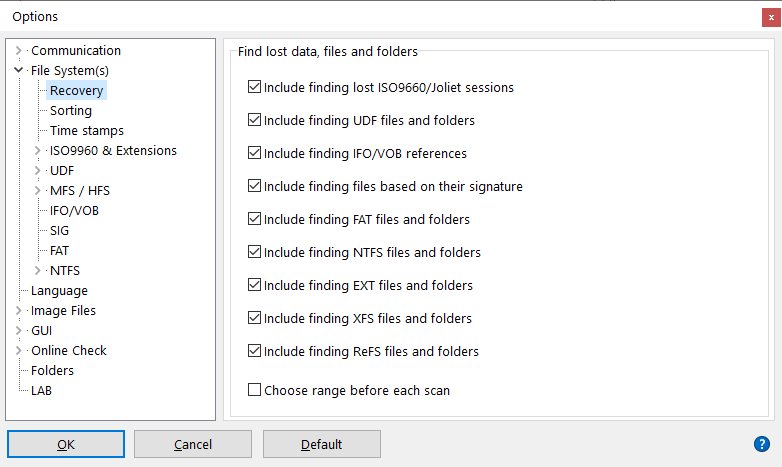Dataredding

Je kunt een scan naar ontbrekende gegevens starten. Tijdens deze scan gebruikt IsoBuster verschillende methoden om ontbrekende bestanden en mappen te vinden. Indien gewenst, bijvoorbeeld voor onderzoeksdoeleinden, kun je individuele tests uitschakelen die tot gegevens leiden.
Inclusief het vinden van verloren ISO9660/Joliet-sessies
Het is mogelijk dat meerdere ISO/Joliet (bestandssysteem) sessies zijn opgenomen in één enkele track of in één enkele (fysieke) sessie. Dit is niet conform de ISO/Joliet-standaard, maar het kan gebeuren. Bijvoorbeeld sommige toepassingen doen dit op DVD+RW en DVD-RW of soms zijn toepassingen zich er niet van bewust dat de vorige sessie niet correct afgesloten was en voegen ze een nieuwe sessie toe, maar nog steeds in de oude sessie. Als IsoBuster deze verborgen bestandssystemen niet automatisch kan vinden en mounten, zal een scan naar ontbrekende bestanden en mappen de gegevens onthullen en zullen de bestandssystemen alsnog worden gevonden en aangemaakt.
Inclusief het vinden van UDF-bestanden en -mappen
Deze scan is aanwezig in IsoBuster vanaf versie 1.1, maar is bij elke nieuwe versie verbeterd en zal blijven verbeteren naarmate nieuwe schrijftoepassingen en versies worden uitgebracht. Deze scan baseert het vinden van ontbrekende gegevens volledig op UDF-bestandssysteemresten. Sporen van UDF kunnen leiden tot verloren mappen en bestanden. IsoBuster puzzelt al deze ontbrekende gegevens samen en kan vaak bestandsnamen, tijdstempels, mapstructuur enz. terughalen.
Inclusief het vinden van IFO/VOB-referenties
Het vinden van het IFO/VOB pseudo-bestandssysteem op VIDEO- en/of AUDIO-DVD’s is gedeeltelijk gebaseerd op andere bestandssystemen. Om dit bestandssysteem te vinden moet er dus een geldig ISO9660- en/of UDF-bestandssysteem aanwezig zijn. Zo niet, dan kan dit pseudo-bestandssysteem niet worden gevonden. Tijdens een scan naar ontbrekende gegevens worden dergelijke pseudo-bestandssystemen echter wel gevonden en beschikbaar gemaakt na de scan. Bovendien kunnen videoregistraties op DVD+VR(W) extra worden gevonden als ze niet via de IFO/VOB-referenties werden gevonden.
Inclusief het vinden van bestanden op basis van hun handtekening
Bestanden zijn vaak herkenbaar op basis van delen van de gegevens in het bestand. Dit is echter geen exacte wetenschap; sommige bestanden worden vrijwel altijd gevonden (bijv. *.jpg) en andere nooit. IsoBuster bouwt een platte bestandslijst op basis van alle bestands-handtekeningen die het tegenkomt. Deze platte lijst bevat alle mogelijke bestanden met een bestandsgrootte tot de volgende aangetroffen handtekening (tenzij je dat wijzigt in de eigenschappen). Uiteraard zijn bestandsnamen niet opgeslagen in de bestandgegevens zelf, dus bestandsnamen en andere eigenschappen zijn onbekend. Desondanks kan deze scan vaak cruciaal zijn voor ontbrekende afbeeldingen, documenten enz., bijvoorbeeld als er geen ISO9660 of UDF beschikbaar is of wanneer deze bestandssystemen te corrupt zijn om nog naar geldige gegevens te verwijzen.
Inclusief het vinden van FAT-bestanden en -mappen
IsoBuster toont de verwijderde bestanden en mappen direct in een apart FAT-bestandssysteem. Dit komt omdat IsoBuster de bestandssysteemvermeldingen scant en daarbij ook de verwijderde vermeldingen tegenkomt. Mappen kunnen echter ook verweesd raken, wat betekent dat er geen verwijzing meer naar hen bestaat. Tijdens een scan naar ontbrekende bestanden en mappen, en als deze optie is ingeschakeld, worden verweesde mappen gevonden en weergegeven in een apart FAT-bestandssysteem. Bovendien vindt IsoBuster ook volledig nieuwe FAT-bestandssystemen indien aanwezig, bijvoorbeeld als het FAT-bestandssysteem niet direct kon worden gevonden door bepaalde onleesbare sectoren, of een FAT-bestandssysteem verderop op de schijf, zoals een tweede of hogere FAT-partitie in een harde schijf-image die niet onmiddellijk werd gevonden.
Inclusief het vinden van NTFS-bestanden en -mappen
Tijdens een scan naar ontbrekende bestanden en mappen, en als deze optie is ingeschakeld, worden verweesde mappen gevonden en weergegeven in een apart NTFS-bestandssysteem. Bovendien vindt IsoBuster volledig nieuwe NTFS-bestandssystemen indien aanwezig, bijvoorbeeld als het NTFS-bestandssysteem niet direct kon worden gevonden door bepaalde onleesbare sectoren, of een NTFS-bestandssysteem verderop op de schijf, zoals een tweede of hogere NTFS-partitie in een harde schijf-image die niet onmiddellijk werd gevonden.
Inclusief het vinden van EXT-bestanden en -mappen
Verstopte, verloren bestandssystemen worden op deze manier gevonden
Inclusief het vinden van XFS-bestanden en -mappen
Verstopte, verloren bestandssystemen worden op deze manier gevonden
Inclusief het vinden van ReFS-bestanden en -mappen
Verstopte, verloren bestandssystemen worden op deze manier gevonden
Kies bereik voor elke scan
Wanneer "Kies bereik voor elke scan" is geselecteerd, kun je elke keer het startadres en het aantal blokken opgeven om een Scan naar ontbrekende bestanden en mappen te starten.